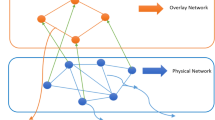Abstract
Managing updates in a peer-to-peer (P2P) network can be a challenging task, especially in the unstructured setting. If one peer reads or updates a data item, then it is desirable to read the most recent version or to have the update visible to all other peers. In practice, this should be accomplished by coordinating and writing to only a small number of peers. We propose two approaches, inspired by hierarchical quorums, to solve this problem in unstructured P2P networks. Our first proposal provides uniform load balancing, while the second sacrifices full load balancing for larger average quorum intersection, and hence greater tolerance to network churn. We demonstrate that applying a random logical tree structure to peers on a per-data item basis allows us to achieve near optimal quorum size, thus minimizing the number of peers that must be coordinated to perform a read or write operation. Unlike previous approaches, our random hierarchical quorums are always guaranteed to overlap at at least one peer when all peers are reachable and, as demonstrated through performance studies, prove to be more resilient to changing network conditions to maximize quorum intersection than previous approaches with a similar quorum size. Furthermore, our two quorum approaches are interchangeable within the same network, providing adaptivity by allowing one to be swapped for the other as network conditions change.
Preview
Unable to display preview. Download preview PDF.
Similar content being viewed by others
References
Kirk, P.: RFC-Gnutella 0.6, http://rfc-gnutella.sourceforge.net/index.html
Liang, J., Kumar, R., Ross, K.W.: The fasttrack overlay: a measurement study. Comput. Netw. 50(6), 842–858 (2006)
Del Vecchio, D., Son, S.H.: Flexible update management in peer-to-peer database systems. In: IDEAS 2005: Proceedings of the 9th International Database Engineering & Application Symposium, Washington, DC, USA, pp. 435–444. IEEE Computer Society Press, Los Alamitos (2005)
Kumar, A.: Hierarchical quorum consensus: A new algorithm for managing replicated data. IEEE Trans. Comput. 40(9), 996–1004 (1991)
National Institute of Standards and Technology. FIPS 180-2, secure hash standard, federal information processing standard (FIPS), publication 180-2. Technical report, Department of Commerce (August 2002)
Joseph, S.: Neurogrid simulation setup, http://www.neurogrid.net/php/simulation.php
Kirk, P.: Gnutella protocol development: Standard message architecture, http://rfc-gnutella.sourceforge.net/developer/testing/message-Architecture.html
Kostoulas, D., Psaltoulis, D., Gupta, I., Birman, K.P., Demers, A.J.: Active and passive techniques for group size estimation in large-scale and dynamic distributed systems. J. Syst. Softw. 80(10), 1639–1658 (2007)
Gifford, D.K.: Weighted voting for replicated data. In: SOSP 1979: Proceedings of the seventh ACM symposium on Operating systems principles, pp. 150–162. ACM, New York (1979)
Cheung, S.Y., Ammar, M.H., Ahamad, M.: The grid protocol: A high performance scheme for maintaining replicated data. IEEE Trans. on Knowl. and Data Eng. 4(6), 582–592 (1992)
Naor, M., Wool, A.: The load, capacity, and availability of quorum systems. SIAM J. Comput. 27(2), 423–447 (1998)
Kumar, A., Rabinovich, M., Sinha, R.K.: A performance study of general grid structures for replicated data. In: Proceedings the 13th International Conference on Distributed Computing Systems, May 1993, pp. 178–185 (1993)
Agrawal, D., El Abbadi, A.: The tree quorum protocol: an efficient approach for managing replicated data. In: Proceedings of the Sixteenth International Conference on Very Large Databases, pp. 243–254. Morgan Kaufmann Publishers Inc., San Francisco (1990)
Jiménez-Peris, R., Patino-Martínez, M., Alonso, G., Kemme, B.: Are quorums an alternative for data replication? ACM Trans. Database Syst. 28(3), 257–294 (2003)
Wool, A.: Quorum systems in replicated databases: science or fiction. Bull. IEEE Technical Committee on Data Engineering 21, 3–11 (1998)
Freisleben, B., Koch, H.-H., Theel, O.: Designing multi-level quorum schemes for highly replicated data. In: Proc. of the 1991 Pacific Rim International Symposium on Fault Tolerant Systems, pp. 154–159. IEEE Computer Society Press, Los Alamitos (1990)
Freisleben, B., Koch, H.-H., Theel, O.: The electoral district strategy for replicated data in distributed systems. In: Proc. of the 5th Intern. Conference of Fault-Tolerant Computing Systems, pp. 100–111 (1991)
Baldoni, R., Jiménez-Peris, R., Patino-Martínez, M., Querzoni, L., Virgillito, A.: Dynamic quorums for DHT-based enterprise infrastructures. J. Parallel Distrib. Comput. 68(9), 1235–1249 (2008)
Brunskill, E.: Building peer-to-peer systems with chord, a distributed lookup service. In: HOTOS 2001: Proceedings of the Eighth Workshop on Hot Topics in Operating Systems, Washington, DC, USA, p. 81. IEEE Computer Society, Los Alamitos (2001)
Zhang, Z.: The power of DHT as a logical space. In: IEEE International Workshop on Future Trends of Distributed Computing Systems, pp. 325–331 (2004)
Lin, S., Lian, Q., Zang, Z.: A practical distributed mutual exclusion protocol in dynamic peer-to-peer systems. In: Voelker, G.M., Shenker, S. (eds.) IPTPS 2004. LNCS, vol. 3279, pp. 11–21. Springer, Heidelberg (2005)
Naor, M., Wieder, U.: Scalable and dynamic quorum systems. Distrib. Comput. 17(4), 311–322 (2005)
Silaghi, B., Keleher, P., Bhattacharjee, B.: Multi-dimensional quorum sets for read-few write-many replica control protocols. In: Fourth International Workshop on Global and Peer-to-Peer Computing (2004)
Author information
Authors and Affiliations
Editor information
Editors and Affiliations
Rights and permissions
Copyright information
© 2009 Springer-Verlag Berlin Heidelberg
About this paper
Cite this paper
Henry, K., Swanson, C., Xie, Q., Daudjee, K. (2009). Efficient Hierarchical Quorums in Unstructured Peer-to-Peer Networks. In: Meersman, R., Dillon, T., Herrero, P. (eds) On the Move to Meaningful Internet Systems: OTM 2009. OTM 2009. Lecture Notes in Computer Science, vol 5870. Springer, Berlin, Heidelberg. https://doi.org/10.1007/978-3-642-05148-7_14
Download citation
DOI: https://doi.org/10.1007/978-3-642-05148-7_14
Publisher Name: Springer, Berlin, Heidelberg
Print ISBN: 978-3-642-05147-0
Online ISBN: 978-3-642-05148-7
eBook Packages: Computer ScienceComputer Science (R0)




